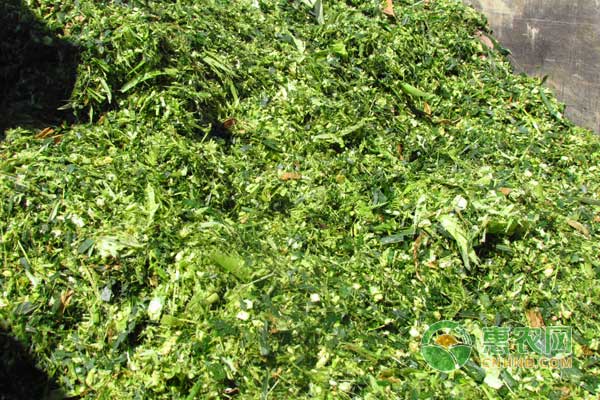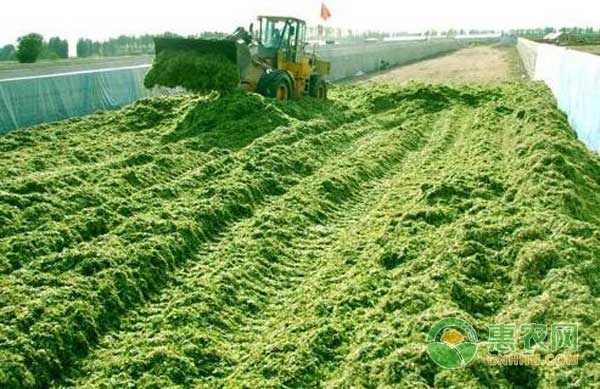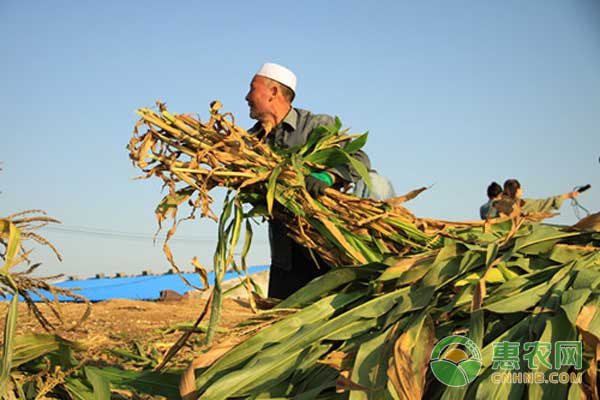After the corn is harvested, the straw can also be made into silage, which can improve the utilization rate of feed, reduce waste of resources, purify the environment, reduce the breeding cost and improve the breeding efficiency. The corn stalk silage technology is described in detail below.

The significance of corn stalk silage
Silage is an economical and safe method of storing feed. It can provide cattle and sheep with green nutrition with high nutritional value and good quality. It can also improve feed utilization. Once a silage can be eaten all year round. Silage is a soft, juicy, fragrant, palatable, nutritious, storable, and versatile feed that keeps the green feed all year round. Corn stalk silage can reduce the loss of straw nutrients, preserve the characteristics of green feed, improve the utilization rate and digestibility of feed, and reduce the environmental pollution caused by corn stover burning. Adding some auxiliary materials can improve feed quality and reduce waste.
Silage construction
The construction of silos should be adapted to local conditions. Simple soil and permanent cement are often used. The former is suitable for farmers with low breeding, and the latter can be applied to large-scale farming with large breeding. Regardless of the type of cockroaches, the site selection should satisfy the conditions of being close to the circle, high ground, avoiding strong light, away from sewage, solid soil, low groundwater level, and no roots around the wall. All the corners of the silage to be built should be smooth, and the upper and lower sides are long and square. Farmers can build a width of 3 m and a depth of 1.5 m, and the length depends on the amount of corn stalks produced by the corn stalk. The scale of the farm can be determined according to the amount of feed. The construction of concrete must be mechanically compacted, generally calculated from silage corn stover 500-600 kg/m3.
Silage operation procedure
1. Preparation of silage machinery
A power reeling machine can be used in places with power supply, and a 20-horsepower diesel engine can be used as a power reeling machine without power. The reeling machine must be close to the sputum for easy filling. The site is flat and free of debris. Safety inspection of all machinery before starting work, cleaning of the tires, and safety precautions.
2. Choose a good time
The best harvest time for corn stalks is before the frost from mid-September to early October. The criterion is that 4 to 5 leaves of the lower part of the corn stalk are dry yellow, and the white line of the corn grain reaches about 50% of the waxy stage. At this time, the water content of the corn stalk should be between 65% and 70%, and the straw stalks have water oozing out to be the best harvesting period for the silage. Frosted straw must not be used as silage. Timely harvesting is the key to the quality of silage. The milk is ripe, the late is ripe, and the wax is ripe. At the time, the yellow leaves are poor, the green leaves are good, and each half is slightly old.
3. Shredded silk in time
Organize the labor and transportation vehicles, and do six things (with cutting, with the pull, with the chopped silk, with the filling, with the compaction, with the seal) one-time completion. The length of straw chopping should be about 1 cm into silk to facilitate compaction, which is conducive to the rapid formation of anaerobic conditions. When harvesting straw, leave more than 10 cm to prevent the film and other debris from entering. The pile site is lined with plastic shed film to prevent the soil from mixing and affecting the silage effect. The method for determining the moisture content of the corn stalks that are chopped and smashed is: grasping a good raw material of glutinous rice and smashing it into a group, the water in the hand sews slightly oozes out, and the stalk of the stalk is suitable. When the raw materials are too dry, sprinkle some water properly. When the raw materials are too wet, they should be dried for a long time.

4. Decoration
The simple soils before installation must be lined with plastic sheds and then filled. The filling must be carried out layer by layer, each layer having a thickness of about 15 cm. Each time a layer of raw material is filled, a mixed auxiliary material is sprayed once (the auxiliary material uses 3 食 of salt, 5 ‰ of urea), and the raw material is thoroughly mixed and then filled and compacted. The addition of excipients can improve the flavor, quality, palatability of silage and the antiseptic effect of silage. The surrounding edges must be manually stepped on, and then filled in layers, until they are about 60 cm high.
5. Seal
The silage is filled and sealed immediately after the ridge is about 60 cm. First seal the left and right sides, and then seal the front side of the mouth. Finally, pull the plastic shed film from the back of the raft to flatten it forward, and cover the soil. The thickness of the cover soil should be about 60 cm. There are two methods of covering soil, one is fine soil covering method, and the other is plastic woven bag covering soil covering method. The latter method is most practical in rural areas, and it is convenient to use. The amount of muck mixed in the silage is small, and the quality of the feed is not affected. The plastic woven bag soil cover method is to fill the bag mouth with 80% fine soil in the plastic woven bag, and gradually stack from the trailing edge of the silage to the mouth of the silo to drain the air in the shed film and promote the anatomy. The oxygen environment is formed as early as possible. After the sealing is finished, a drainage ditch is dug 20 cm away from the edge of the clam, and it is necessary to check frequently. It is found that when the crack is formed, the fine soil seal should be filled in time to prevent rain and water seepage. In order to prevent the plastic woven bag from being differentiated by the wind and the sun, a layer of wheat straw can be covered thereon.
6.Quality identification and access
Silage can be used for feeding after 40 to 45 days. Good quality silage still maintains or is close to the original turquoise, with a slightly sour taste. Grab a soft and moist texture, and then loosen your hands when loosened. The amount of reclaimed material is determined according to the number of livestock, and it is taken at a certain width for one time, and then the mouth is sealed to prevent secondary fermentation to produce heat and mildew. Pay attention to the following matters when feeding:
Layered reclaiming
When using silage, take it at a certain width from the mouth before the mouth, so that the silage feed surface always maintains a plane, remember to dig the hole for use.
Timely sealing the mouth
After the silage is taken out, the mouth is sealed in time to prevent the silage interface from being exposed to the air and causing secondary fermentation deterioration. After feeding, it causes livestock poisoning, diarrhea, and pregnant female abortion.
Feeding from less to more
Silage is slightly sour. Some livestock are not used to feeding when starting feeding. In order to make the cattle and sheep have an adaptation process, the feeding amount should be gradually increased from small to large or mixed into other forages to gradually adapt the cattle and sheep. The feeding amount of silage should be controlled at 20 kg/d for dairy cows and fattening cattle, 15 kg/d for working cattle, 5 kg/d for adult sheep, 10 kg/d for horses, and less for pregnant females. Mix the hay for feeding.
Reasonable match
When feeding, it must be properly matched with the concentrate and other feeds according to the nutritional needs of the livestock. Silage can be fed at the beginning of feeding, and concentrates and other feeds can be fed after adaptation. Silage and other feeds can also be mixed to improve feed utilization.
Treated acid silage
If the acidity of the silage is too large, the amount of feed should be reduced or treated. It can be fed with 5% to 10% lime in water, or 12% baking soda can be added to the concentrate to reduce the acidity in the stomach.

Do not use metamorphic feed
If the silage is found to be black, brown or dark green, the smell of sour is pungent, spoiled and musty, and the texture is sticky. Do not use it for feeding.
It is necessary to grasp the various links of corn stalk silage, such as the harvesting time of the raw materials, the length of the silage time, the ratio of the auxiliary materials and the uniformity of the raw materials, the tightness of the seal, etc., only to do the above work to make a perfect Silage.
Anthocyanins widely exist in flowering plants (angiosperms), and their content in plants varies greatly with varieties, seasons, climate and maturity[ 5] According to preliminary statistics, anthocyanins are contained in 27 families and 73 genera, such as purple sweet potato, grape, blood orange, red ball cabbage, blueberry, eggplant, cherry, red berry, strawberry, mulberry, hawthorn, morning glory and other plant tissues. Anthocyanins are mainly used in food coloring, dyes, medicine, cosmetics and so on.
Application
Antioxidant and free radical scavenging function
Anthocyanins belong to bioflavonoids, and the main physiological functions of flavonoids are free radical scavenging ability and antioxidant ability. Studies have proved that anthocyanins are the most effective antioxidants and the most powerful free radical scavengers found by human beings. The antioxidant performance of anthocyanins is 50 times higher than that of VE and 20 times higher than that of VC. Purple Sweet Potato Anthocyanin products can scavenge and inhibit - Oh, H2O2 and other reactive oxygen species, especially - Oh is stronger than ascorbic acid, and the scavenging effect is dose-dependent with concentration.
Anti mutation function
The function of anthocyanins not only makes plants present colorful colors, but also active molecules with health functions such as reducing enzyme activity and anti mutation. Studies have shown that the extract with a certain concentration of anthocyanin can effectively prevent carcinogenesis at different stages, but the individual role of anthocyanin is uncertain, partly because anthocyanin is easy to degrade after bioassay after separation from other stable components such as phenols.
Application in food
With the development of science and technology, people pay more and more attention to the safety of Food Additives. The development and utilization of natural additives has become the general trend of the development and use of additives. Anthocyanins can not only be used as nutritional enhancers in food, but also as food preservatives instead of synthetic preservatives such as benzoic acid, and can be used as food colorants in ordinary drinks and food, which meets people's general requirements for natural, safe and healthy food additives.
Blueberry JuicePowder, Elderberry Fruit Powder, Blackcurrant Extract Powder, Black Wolfberry Extract
Xi'an Tian Guangyuan Biotech Co., Ltd. , https://www.tgybiotech.com